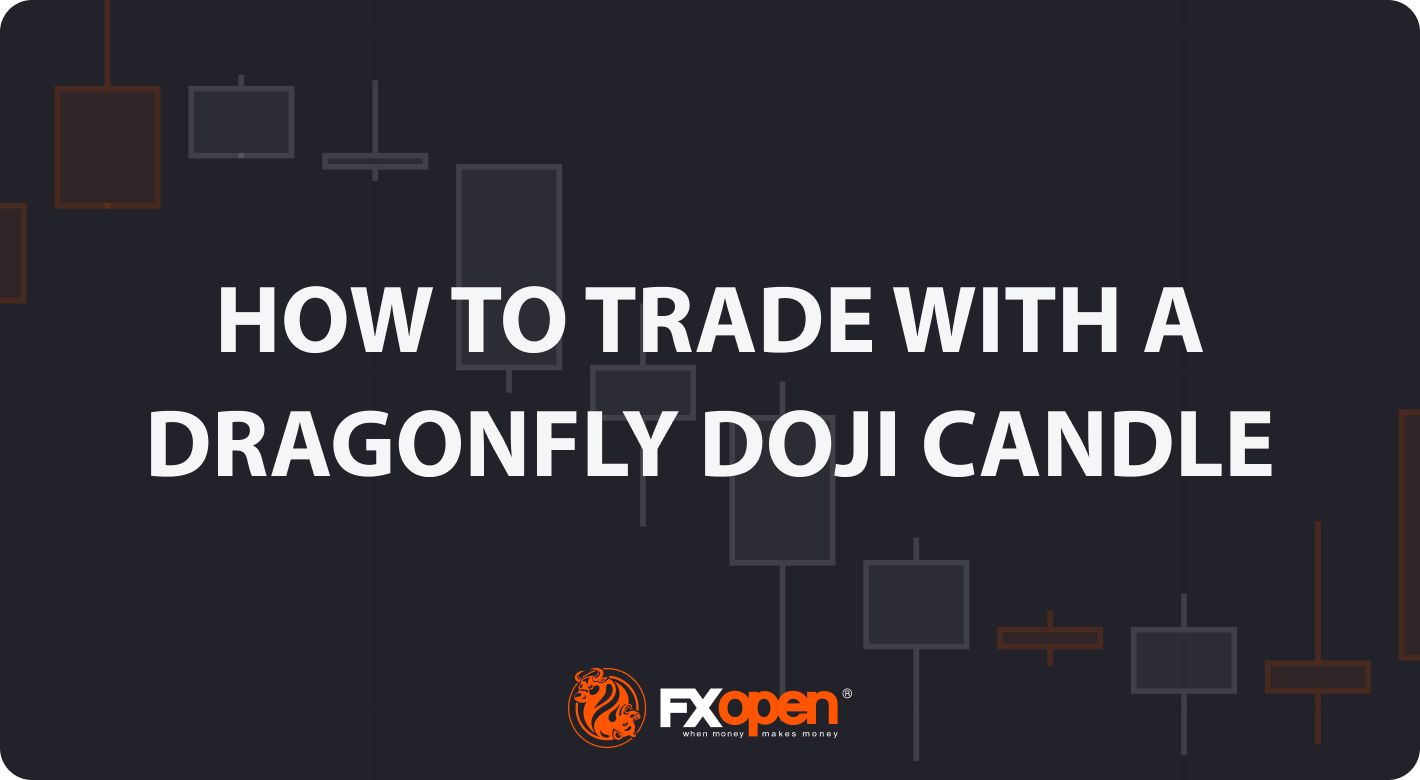FXOpen

The dragonfly doji candlestick pattern holds intrigue and fascination for traders in financial markets. Its distinct shape and positioning on technical charts make it a keen subject for observation and analysis. In this article, we will explore the setup, its significance, and how traders can interpret it in their trading strategies.
What Does a Dragonfly Doji Mean?
The red or green dragonfly doji is a candlestick pattern that forms when the opening, closing, and high prices of an asset are equal or almost equal. This pattern resembles the shape of a dragonfly with an extended lower shadow. It provides bullish signals and is considered a neutral continuation or reversal pattern, depending on its context within a trend. The meaning of a dragonfly doji is that there is uncertainty in the market, and traders are prompted to carefully analyse other factors before making trading decisions.
Traders may find the dragonfly doji pattern on charts of different financial instruments, such as stocks, cryptocurrencies*, ETFs, indices, and forex, regardless of the timeframe. You can test this pattern on various markets with the FXOpen platform.
How to Identify the Setup
To identify the green or red dragonfly doji, you need to look for the following characteristics:
- The open, close, and high prices should be the same or nearly the same, indicating indecision in the market.
- The candlestick should have an extended lower shadow, indicating that the price reached a notable low during the trading period but couldn’t stay there.
How to Trade the Dragonfly Doji
The bullish dragonfly doji can provide valuable information about market sentiment and potential reversals. Here are two scenarios where the formation can be significant:
Dragonfly Doji in an Uptrend
The dragonfly doji at the top of a bullish trend is generally seen as a continuation pattern. This is because, despite sellers attempting to push the market lower, buyers remain active and prevent a significant decline. However, it is worth noting that the inability of buyers to push the market above may indicate a potential weakening of bullish momentum. Traders may enter the trade above the open/close of the doji’s candle or if the proceeding bar closes above the doji’s open or close.
In the chart above, there is a pattern in an uptrend where the trader places a long trade on the next bar. The stop loss is set below the candle with the take profit at the closest resistance.
Dragonfly Doji in a Downtrend
The dragonfly doji in bearish markets may suggest a possible reversal. The long lower shadow indicates that buyers entered the market, pushing the market up from its lows. This could be seen as a signal to consider going long or watching for a further bullish confirmation before taking action. Traders may place a stop loss below the bar with a take profit at the closest resistance level or may consider the risk/reward ratio.
The setup at the end of a downtrend signals a reversal. The trader places a buy order at the high of the doji bar with a stop loss level below it. The take profit is calculated based on the risk/reward ratio.
Traders can enhance their trading strategies by utilising the free TickTrader platform, which allows them to leverage their price action skills.
Dragonfly and Other Doji Types
Dragonfly doji, gravestone doji, spinning top, and long-legged doji are all types of candlestick patterns commonly used in technical analysis to indicate potential reversals or indecision in the market. Traders often pay close attention to them when making trading decisions.
Dragonfly Doji vs Gravestone Doji
While the dragonfly doji has a long lower shadow and little or non-existent upper one, the gravestone or inverted dragonfly doji has a long upper wick and little or non-existent lower one. Both patterns indicate indecision, but the dragonfly provides bullish signals, whereas the gravestone indicates potential bearish reversals.
Dragonfly Doji vs Spinning Top
A spinning top bar has a small real body and long upper and lower shadows. It represents a state of indecision between buyers and sellers. The main difference between the dragonfly and the spinning top is that there is little/no upper shadow in the former. A dragonfly indicates a stronger bullish signal than a spinning top, as it suggests a potential trend reversal. Traders should remember that a spinning top may provide both bearish and bullish signals.
Gravestone Doji vs Long-Legged Doji
The gravestone has a long upper shadow and no lower one, while the long-legged doji has both upper and lower shadows of approximately equal length. The former typically represents bearish sentiment and potential reversals, indicating that sellers have taken control, while the latter suggests indecision and a balance between buyers and sellers, often reflecting consolidation or uncertainty in the market.
Closing Thoughts
Candlestick patterns should not be the sole basis for trading decisions, and it is always prudent to conduct a thorough analysis and risk management procedure before entering any trades. To improve decision-making and identify profitable trading opportunities, traders need to understand the implications of the pattern within the broader market context and employ effective risk management strategies. Once traders have confidence in their analysis, they can open an FXOpen account to actively participate in live market trading.
*At FXOpen UK and FXOpen AU, Cryptocurrency CFDs are only available for trading by those clients categorised as Professional clients under FCA Rules and Professional clients under ASIC Rules, respectively. They are not available for trading by Retail clients.
This article represents the opinion of the Companies operating under the FXOpen brand only. It is not to be construed as an offer, solicitation, or recommendation with respect to products and services provided by the Companies operating under the FXOpen brand, nor is it to be considered financial advice.
Stay ahead of the market!
Subscribe now to our mailing list and receive the latest market news and insights delivered directly to your inbox.








